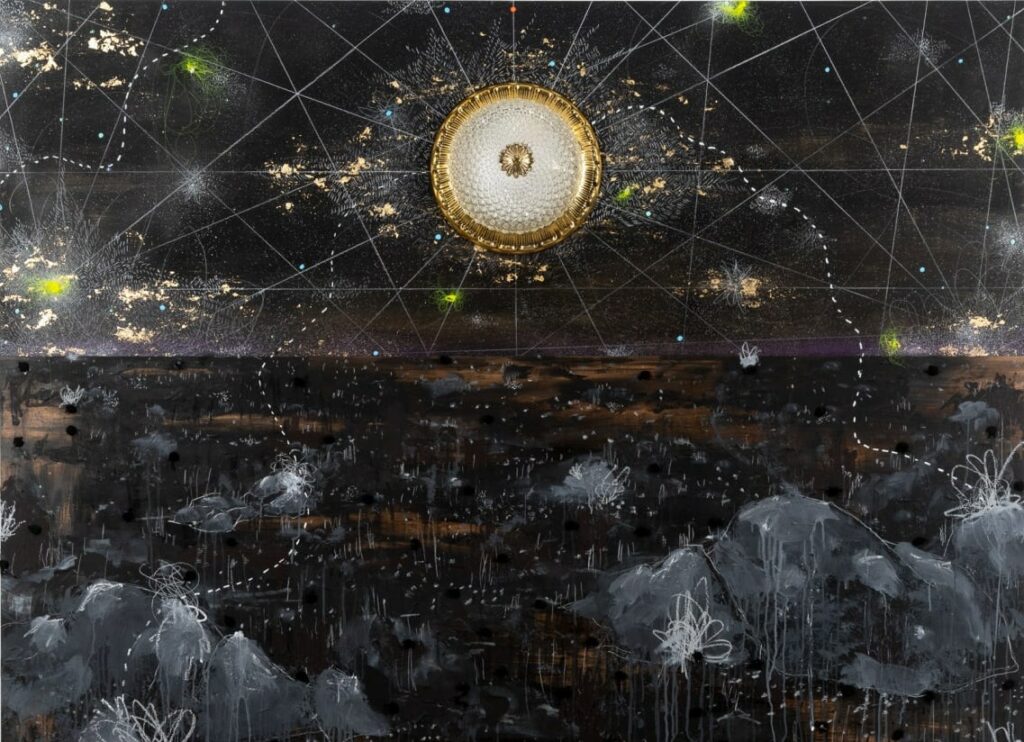Kavi Gupta, Washington D.C., United States
04 Jun 2022 - 30 Jul 2022

Michi Meko, Cucka Bugs: Cold Was The Ground. Barren Trails (Detail), 2022, acrylic, aerosol, oil pastel, gold leaf, aerosol hologram glitter, white colored pencil. India ink sequins, tassel, 4lb Mr Crappie Hi Viz mono lament, gouache, wood satin on panel, 75 x 73 in.
Kavi Gupta presents Dark was the Night, Cold was the Ground, a solo exhibition and catalogue of new work by Michi Meko, Joan Mitchell Foundation Grantee and Artadia Award winner. Featuring works created entirely during the COVID-19 pandemic, the exhibition reflects on Meko’s ideas and experiences during isolation, and follows Meko’s inclusion in the acclaimed traveling group exhibition The Dirty South.
Solitude is a strange currency—enriching to those who can mobilize its potential; a liability to those who cannot. For many of us, the forced isolation imposed by the COVID-19 pandemic exacerbated existing feelings of loneliness. When Meko saw the world going into quarantine back in 2020, he decided to embrace the inevitable. Packing a go bag and heading by himself deep into the north Georgia woods, he instigated an isolation within an isolation, and found visibility within invisibility.
“Being Black in the wilderness is an idea I’ve been trying to chase down or play with for a long time,” Meko says. “2020 gave me a green light to just take off and see what that’s like. I wrote a book of field notes and took photographs and made drawings. A lot of it was trying to hear my voice and understand what that meant—to hear one’s own voice in wild spaces. What does a Black man sound like in a wilderness, versus the voice of John Muir or Ernest Hemingway or somebody like that?”
Exhibited within a sound and lighting world evocative of a lonesome campfire in the mountains, Dark was the Night, Cold was the Ground symbolically and abstractly depicts both the geographical and psychological wildernesses through which Meko has traveled. Some works are painted from the perspective of being inside the thicket. Some are exhibited high up, so the viewer must crane their head. Several are painted from an elevated, expansive vantage point, what Meko describes as a fugitive view, echoing poet Fred Moten’s description of fugitivity as an aspirational striving for a transformative escape from the bondage of the commonplace.
Some of Meko’s works are pure abstractions. Others resemble childlike hump hills, obliterated by mark making. Where the work is less concerned with representation, it engages more with the inward landscape.
“That’s what this work is about,” Meko says. “Exploring inwardly. Getting into a space of leisure, then once you’re in there, trying to find the calm or transcendent moment where one can hear their voice.”
Meko’s rigorous studio practice has always been grounded in a material, metaphorical, and philosophical examination of what he calls “the African American experience of navigating public spaces, particularly in the American South, while remaining buoyant within them.” Incorporating romanticized found objects as well as the visual language of mapping, flags, and wayfinding into his work, he constructs transcendent aesthetic spaces into which the viewer’s psyche is free to wander.
Continuing his longstanding practice of activating the allegorical content of his materials, Meko introduces two new mediums in Dark was the Night, Cold was the Ground: fish scales and yellow corn grits. An avid fisherman who makes his own lures, Meko blended the fish scales into his paints, endowing the surfaces of his abstracted landscapes with an otherworldly glint and glitter, like silver moonlight reflecting on an effervescent pond. The yellow corn grits, sourced from a local miller near Rabun Gap, an area where Meko likes to camp, add a coarse and weighty earthiness to the work.
“These gestures are Southern gestures,” Meko says. “What we see now in the art market, where there’s portrait painters, I decided to make my portraits of what Black life looks like and take that into the abstract, and paint what that energy of a Black soul looks like. This is a way to get me where a lot of artists aren’t thinking, and to further isolate myself, to push my aesthetics, my philosophy, or pedagogy further beyond the norm.”
Recent exhibitions of Meko’s work include The Dirty South, Virginia Museum of Fine Art, Richmond, VA; Realms of Refuge, Kavi Gupta, Chicago, IL; Michi Meko: Black and Blur, Clark Atlanta University Art Museum, Atlanta GA; Michi Meko: It Doesn’t Prepare You for Arrival,Museum of Contemporary Art of Georgia (MOCA GA), Atlanta, GA; Michi Meko: Before We Blast off: The Journey of Divine Forces, Atlanta Contemporary Art Center, Atlanta, GA; and Abstraction Today, MOCA GA, Atlanta, GA. His work is held in the collections of the High Museum of Art, Atlanta, GA; King & Spalding, Atlanta, GA; Scion (Toyota Motor Corporation), Los Angeles, CA; MetroPark USA Inc., Atlanta, GA; and CW Network, Atlanta, GA, among others. Meko is the recipient of the Joan Mitchell Foundation Grant and the Atlanta Artadia Award, and was a finalist for the 2019 Hudgens Prize.